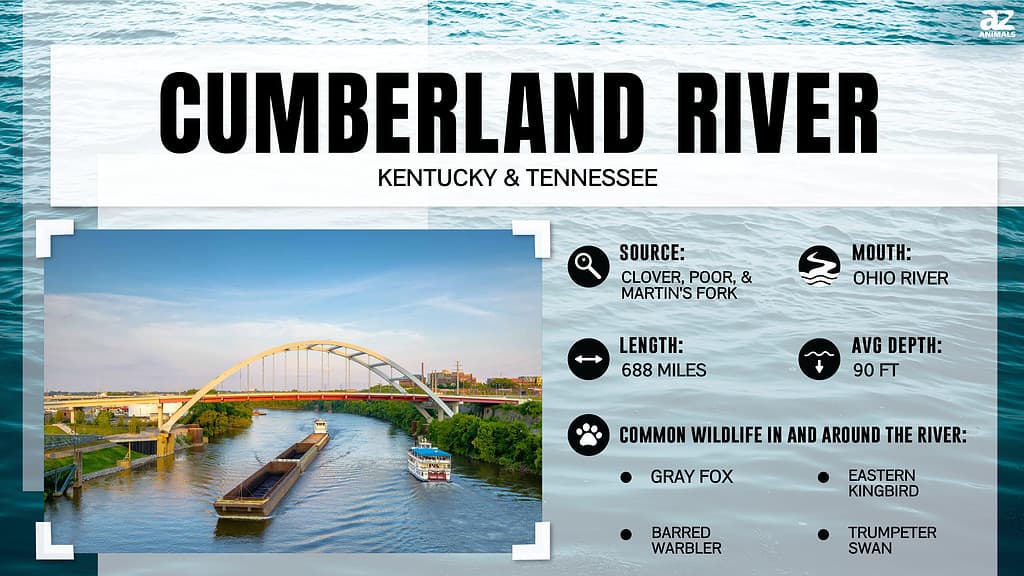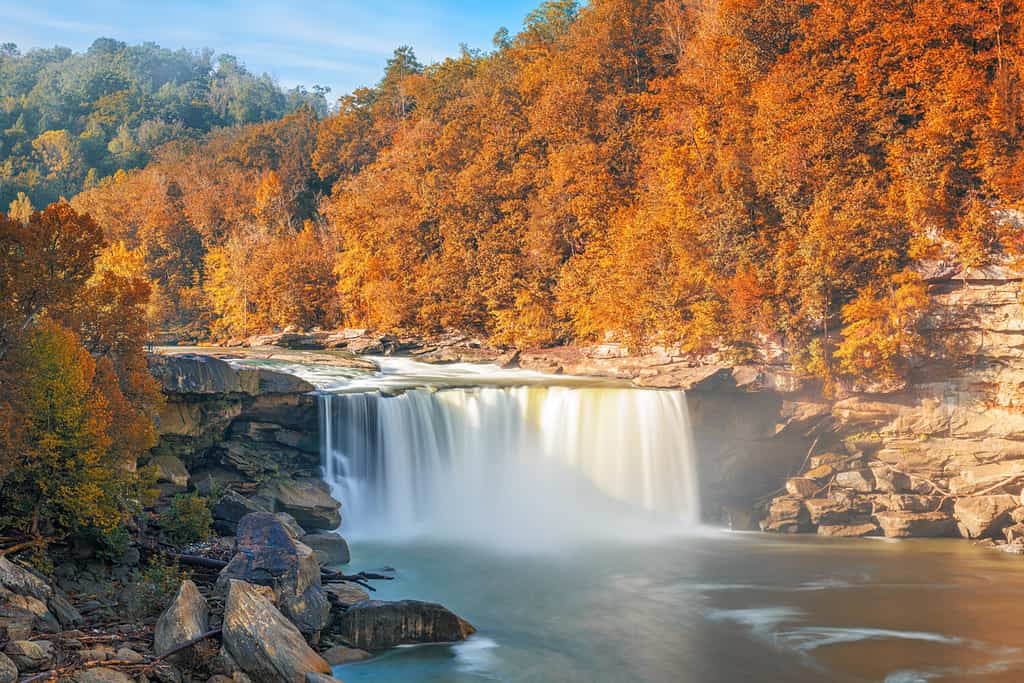The Cumberland River is a significant waterway, winding its way from the Appalachian Mountains through Kentucky and Tennessee before emptying itself into the waters of the Ohio River. From its days as a resource for indigenous American nations to its modern presence in the United States, the river has undergone numerous transformations by adding dams, locks, and reservoirs along its 688-mile length. So, how wide is the Cumberland River at its widest point?

How Wide Is the Cumberland River at its Widest Point?
For the most part, the Cumberland River is narrow, channeling between 600-foot-wide gaps in limestone throughout its course. As lakes (impoundments) are considered part of the rivers they contain, the widest point along the river is bound to be within one of its lakes. At its widest point (Lake Barkley), the Cumberland River measures about 2 miles across.
How Large Is the Cumberland River in Volume?

The streamflow at Cumberland Falls is an impressive reminder of the river’s volume.
©Sean Pavone/Shutterstock.com
It isn’t easy to measure the volume of a river. After all, it is a moving body of water. Additionally, precipitation levels upstream, downstream, or on the tributaries can cause much fluctuation throughout the system. Consequently, the most common way to measure river volume is to measure streamflow at multiple USGS monitors along the riverway. At each monitoring station, gauges measure a current’s depth, width, and speed. Hydrologists frequently calibrate these stations. These measurements are then expressed in terms of how many cubic feet (f³) flow past in a second. Hydrologists add streamflow measurements from each river station to approximate the river’s total streamflow. The average streamflow for the Cumberland River is approximately 30,000 f³/s over five stations along the river.
Which Main Tributaries Supply the Cumberland River?
The Cumberland River has many tributary rivers on its “left” and “right” banks. On the left, looking downstream, Martins Fork, Clear Fork, Big South Fork, Obey River, Caney Fork River, Stones River, and Harpeth River join the Cumberland. You have Clover Fork, Poor Fork, Laurel River, Rockcastle River, Red River, and Little River on the right. Some of these tributaries are the main features in watersheds named after them throughout the Cumberland basin.
How Large Is the Cumberland River Watershed?
The area surrounding the Cumberland River is actually a basin containing 14 separate watersheds. These watersheds cover nearly 18,000 square miles, including portions of 70 Kentucky and Tennessee Counties and over 22,000 miles of rivers and streams.
Cumberland River Basin Watersheds:
- Upper Cumberland
- Rockcastle River
- South Fork of the Cumberland River
- Lake Cumberland
- Obey River
- Cordell Hull
- Caney Fork River
- Old Hickory
- Stones River
- Collins River
- Red River
- Middle Cumberland
- Harpeth River
- Lower Cumberland
How Does the Cumberland River Compare to the Tennessee River?

The Tennessee River plays a similar role in Kentucky and Tennessee to that of the Cumberland River.
©Kevin Ruck/Shutterstock.com
The Cumberland and Tennessee rivers are vital commercial waterways for Tennessee and Kentucky. The U.S. Army Corps of Engineers Nashville District operates the locks and dams along both navigable waterways. Though shallower, the Tennessee River more than doubles the Cumberland in volume and the size of its watersheds. This is partly due to the terrain and the greater width of the Tennessee River.
| Cumberland River | Tennessee River | |
|---|---|---|
| Length | 688 | 652 |
| Depth | 90 | 9 |
| Volume | 30,000 f³/s | 68,000 f³/s |
| Watershed | 18,000 square miles | 40,876 square miles |
What Wildlife Lives Around the Cumberland River?

Trumpeter swans are one of many bird species passing through the Cumberland River basin yearly.
©Danita Delimont/Shutterstock.com
The Cumberland River watershed is a haven for wildlife throughout Kentucky and Tennessee. The waters attract bald eagles, ospreys, and great blue herons. Migratory populations of trumpeter swans, ducks, and geese pass through, finding food and shelter as they follow the seasons. The waters team with bass and sunfish, attracting otters and other mammals along the river’s banks. Beavers are drawn to the surrounding vegetation. The wooded shores are home to white-tailed deer, coyotes, raccoons, and opossums. Common box turtles, eastern newts, eastern copperheads, and gray rat snakes are widely found throughout the region. This is just a tiny sampling of the wildlife that calls the Cumberland River home.
Why Is the Cumberland River Vital?
Before the European colonization of the Americas, native peoples used the waterways for travel and survival. In the 18th century, the Cumberland River was a key waterway supporting the westward expansion of colonial interests and settlements. By the 19th century, the river was a major commercial waterway for cargo and people carried on riverboats. The cities along the Cumberland grew and prospered, bringing economic development to the region. The river was also a strategic route for Union forces to push into the Confederacy during the Civil War.
Today, the Cumberland River is an essential water source for consumption, sanitation, agriculture, and industry. It is also a major waterway for interstate shipping where the eastern and southern U.S. meet. In 2019, the river carried over 6,700 recreation, commercial, and other vessels through its four locks. Over 23,000,000 tons of cargo passed through the locks in the same year. Visitors are also drawn to the beautiful watershed of the Cumberland River to boat, swim, ski, and fish.
Where Is the Cumberland River Located on a Map?
The photo featured at the top of this post is © Sean Pavone/Shutterstock.com
Thank you for reading! Have some feedback for us? Contact the AZ Animals editorial team.






